1. Introduction
This lecture takes what you have learned in establishing a MongoDB data tier using Spring Data MongoDB and shows that integrated into an end-to-end application with API CRUD calls and finder calls using paging. It is assumed that you already know about API topics like Data Transfer Objects (DTOs), JSON and XML content, marshalling/unmarshalling using Jackson and JAXB, web APIs/controllers, and clients. This lecture will put them all together.
|
Due to the common component technologies between the Spring Data JPA and Spring Data MongoDB end-to-end solution, this lecture is about 95% the same as the Spring Data JPA End-to-End Application lecture. Although it is presumed that the Spring Data JPA End-to-End Application lecture precedes this lecture — it was written so that was not a requirement. If you have already mastered the Spring Data JPA End-to-End Application topics, you should be able to quickly breeze through this material because of the significant similarities in concepts and APIs. |
1.1. Goals
The student will learn:
-
to integrate a Spring Data MongoDB Repository into an end-to-end application, accessed through an API
-
to make a clear distinction between Data Transfer Objects (DTOs) and Business Objects (BOs)
-
to identify data type architectural decisions required for a multi-tiered application
-
to understand the need for paging when working with potentially unbounded collections and remote clients
1.2. Objectives
At the conclusion of this lecture and related exercises, the student will be able to:
-
implement a BO tier of classes that will be mapped to the database
-
implement a DTO tier of classes that will exchange state with external clients
-
implement a service tier that completes useful actions
-
identify the controller/service layer interface decisions when it comes to using DTO and BO classes
-
implement a mapping tier between BO and DTO objects
-
implement paging requests through the API
-
implement page responses through the API
2. BO/DTO Component Architecture
2.1. Business Object(s)/@Documents
For our Books application — I have kept the data model simple and kept it limited to a single business object (BO) @Document class mapped to the database using Spring Data MongoDB annotations and accessed through a Spring Data MongoDB repository.
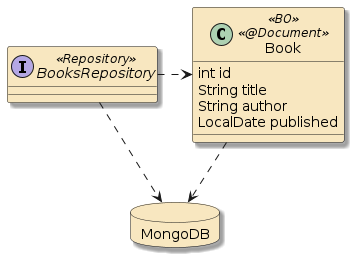
Figure 1. BO Class Mapped to DB as Spring Data MongoDB @Document
|
The business objects are the focal point of information where we implement our business decisions. |
The primary focus of our BO classes is to map business implementation concepts to the database. There are two fundamental patterns of business objects:
-
Anemic Domain Model - containing no validations, calculations, or implementation of business rules. A basic data mapping with getters and setters.
-
Rich Domain Model - combining data with business behavior indicative of an Object-Oriented design. The rich domain model is at the heart of Domain Driven Design (DDD) architectural concepts.
Due to our simplistic business domain, the example business object is very anemic. Do not treat that as a desirable target for all cases.
The following snippet shows some of the optional mapping properties of a Spring Data MongoDB @Document class.
import org.springframework.data.annotation.Id;
import org.springframework.data.mongodb.core.mapping.Document;
import org.springframework.data.mongodb.core.mapping.Field;
@Document(collection = "books") (1)
...
public class Book {
@Id (2)
private String id;
@Field(name="title") (3)
private String title;
private String author;
private LocalDate published;
...| 1 | @Document.collection used to define the DB collection to use — otherwise uses name of class |
| 2 | @Id used to map the document primary key field to a class property |
| 3 | @Field used to custom map a class property to a document field — the example is performing what the default would have done |
2.2. Data Transfer Object(s) (DTOs)
The Data Transfer Objects are the focal point of interfacing with external clients. They represent state at a point in time. For external web APIs, they are commonly mapped to both JSON and XML.
For the API, we have the decision of whether to reuse BO classes as DTOs or implement a separate set of classes for that purpose. Even though some applications start out simple, there will come a point where database technology or mappings will need to change at a different pace than API technology or mappings.

Figure 2. DTO
|
For that reason, I created a separate |
The primary focus of our DTO classes is to map business interface concepts to a portable exchange format.
2.3. BookDTO Class
The following snippet shows some of the annotations required to map the BookDTO class to XML using Jackson and JAXB.
Jackson JSON requires very few annotations in the simple cases.
import com.fasterxml.jackson.dataformat.xml.annotation.JacksonXmlRootElement;
import com.fasterxml.jackson.dataformat.xml.annotation.JacksonXmlProperty;
import jakarta.xml.bind.annotation.XmlRootElement;
import jakarta.xml.bind.annotation.XmlAccessType;
import jakarta.xml.bind.annotation.XmlAccessorType;
...
@JacksonXmlRootElement(localName = "book", namespace = "urn:ejava.db-repo.books")
@XmlRootElement(name = "book", namespace = "urn:ejava.db-repo.books") (2)
@XmlAccessorType(XmlAccessType.FIELD)
@NoArgsConstructor
...
public class BookDTO { (1)
@JacksonXmlProperty(isAttribute = true)
@XmlAttribute
private String id;
private String title;
private String author;
@XmlJavaTypeAdapter(LocalDateJaxbAdapter.class) (3)
private LocalDate published;
...| 1 | Jackson JSON requires very little to no annotations for simple mappings |
| 2 | XML mappings require more detailed definition to be complete |
| 3 | JAXB requires a custom mapping definition for java.time types |
2.4. BO/DTO Mapping
With separate BO and DTO classes, there is a need for mapping between the two.
|
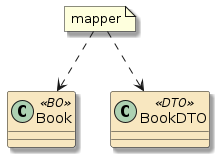
Figure 3. BO to DTO Mapping
|
We have several options on how to organize this role.
2.4.1. BO/DTO Self Mapping
|
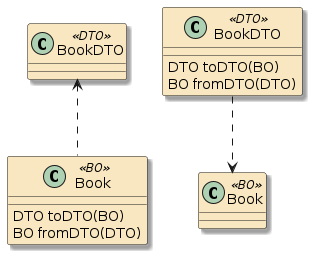
Figure 4. BO to DTO Self Mapping
|
2.4.2. BO/DTO Method Self Mapping
|
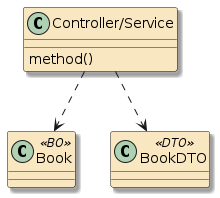
Figure 5. BO to DTO Method Self Mapping
|
2.4.3. BO/DTO Helper Method Mapping
|
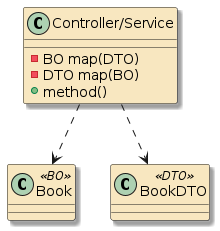
Figure 6. BO/DTO Helper Method Mapping
|
2.4.4. BO/DTO Helper Class Mapping
|
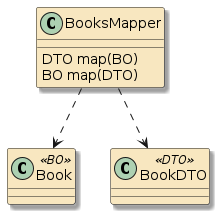
Figure 7. BO/DTO Helper Class Mapping
|
2.4.5. BO/DTO Helper Class Mapping Implementations
Mapping helper classes can be implemented by:
-
brute force implementation
-
Benefit: likely the fastest performance and technically simplest to understand
-
Drawback: tedious setter/getter code
-
-
off-the-shelf mapper libraries (e.g. Dozer, Orika, MapStruct, ModelMapper, JMapper) [1] [2]
-
Benefit:
-
declarative language and inferred DIY mapping options
-
some rely on code generation at compile time (similar in lifecycle to Lombok in some ways) with the ability to override and customize
-
-
Drawbacks:
-
some rely on reflection for mapping which add to overhead
-
non-trivial mappings can be complex to understand
-
-
|
MapStruct Thumbs Up
I have personally used Dozer in detail (years ago) and have recently been introduced to MapStruct.
I really like MapStruct much better.
It writes much of the same code you would have written in the brute force approach — without using reflection at runtime.
You can define a mapper through interfaces and abstract classes — depending on how much you need to customize.
You can also declare the mapper as a component to have helper components injected for use in mapping.
In the end, you get a class with methods written in Java source that you can clearly see.
Everything is understandable.
|
3. Service Architecture
Services — with the aid of BOs — implement the meat of the business logic.
The service
Example Service Class Declaration
|
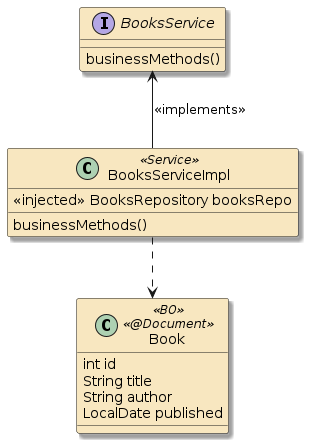
|
3.1. Injected Service Boundaries
Container features like @Secured, @Async, etc. are only implemented at component boundaries.
When a @Component dependency is injected, the container has the opportunity to add features using "interpose".
As a part of interpose — the container implements proxy to add the desired feature of the target component method.
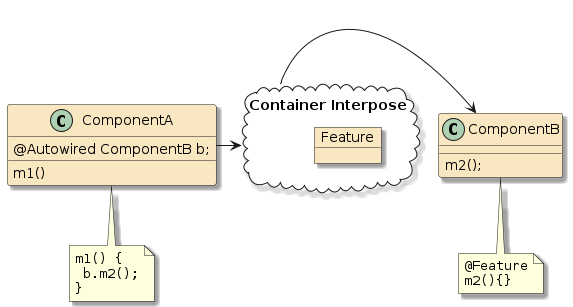
Therefore it is important to arrange a component boundary wherever you need to start a new characteristic provided by the container. The following is a more detailed explanation of what not to do and do.
3.1.1. Buddy Method Boundary
The methods within a component class are not typically subject to container interpose. Therefore a call from m1() to m2() within the same component class is a straight Java call.
|
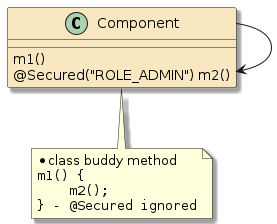
Figure 9. Buddy Method Boundary
|
3.1.2. Self Instantiated Method Boundary
Container interpose is only performed when the container has a chance to decorate the called component. Therefore, a call to a method of a component class that is self-instantiated will not have container interpose applied — no matter how the called method is annotated.
|
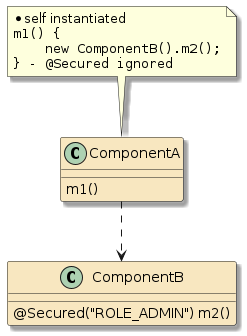
Figure 10. Self Instantiated Method Boundary
|
3.1.3. Container Injected Method Boundary
Components injected by the container are subject to container interpose and will have declared characteristics applied.
|
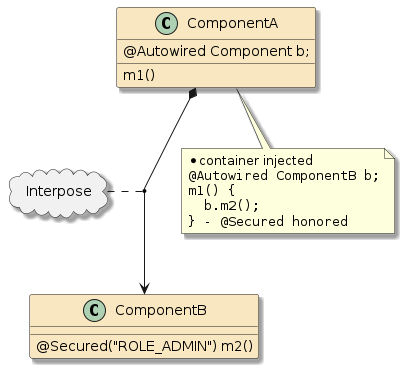
Figure 11. Container Injected Method Boundary
|
3.2. Compound Services
With @Component boundaries and interpose constraints understood — in more complex security, or threading solutions, the logical @Service many get broken up into one or more physical helper @Component classes.
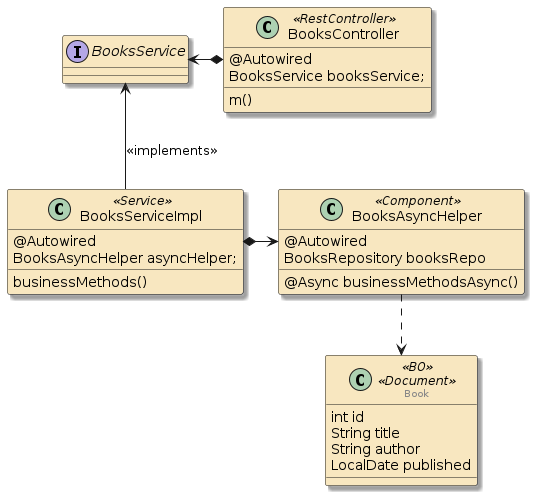
Figure 12. Single Service Expressed as Multiple Components
|
Each helper To external users of
|
4. BO/DTO Interface Options
With the core roles of BOs and DTOs understood, we next have a decision to make about where to use them within our application between the API and service classes.
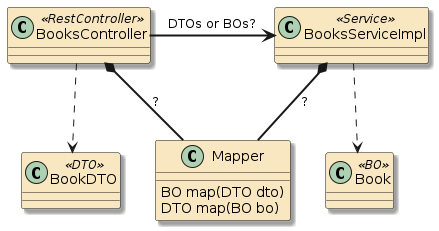
Figure 13. BO/DTO Interface Decisions
|
|
4.1. API Maps DTO/BO
It is natural to think of the @Service as working with pure implementation (BO) classes.
This leaves the mapping job to the @RestController and all clients of the @Service.
|
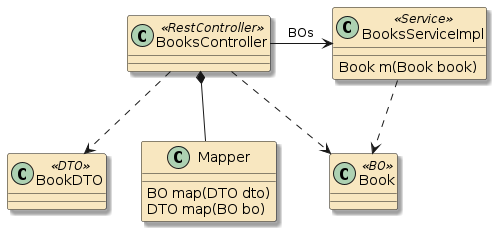
Figure 14. API Maps DTO to BO for Service Interface
|
4.2. @Service Maps DTO/BO
Alternatively, we can have the @Service fully encapsulate the implementation details and work with DTOs in its interface.
This places the job of DTO/BO translation to the @Service and the @RestController and all @Service clients work with DTOs.
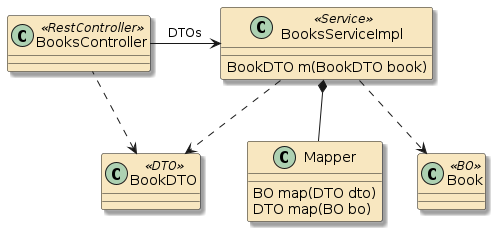
Figure 15. Service Maps DTO in Service Interface to BO
|
|
4.3. Layered Service Mapping Approach
The later DTO interface/mapping approach just introduced — maps closely to the Domain Driven Design (DDD) "Application Layer". However, one could also implement a layering of services.
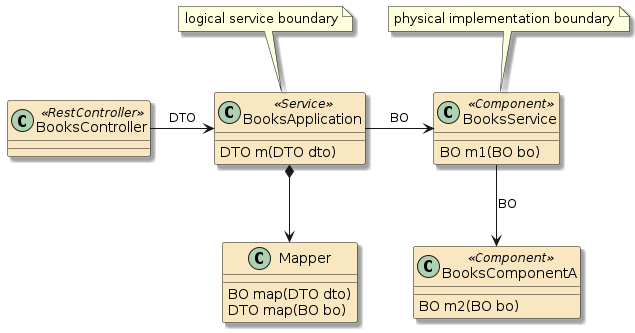
|
|
|
Layered Services Permit a Level of Trust between Inner Components
When using this approach, I like:
|
5. Implementation Details
With architectural decisions understood, lets take a look at some of the key details of the end-to-end application.
5.1. Book BO
We have already covered the Book BO @Document class in a lot of detail during the MongoTemplate lecture.
The following lists most of the key business aspects and implementation details of the class.
package info.ejava.examples.db.mongo.books.bo;
...
@Document(collection = "books")
@Builder
@With
@ToString
@EqualsAndHashCode
@Getter
@Setter
@AllArgsConstructor
public class Book {
@Id @Setter(AccessLevel.NONE)
private String id;
@Setter
@Field(name="title")
private String title;
@Setter
private String author;
@Setter
private LocalDate published;
}5.2. BookDTO
The BookDTO class has been mapped to Jackson JSON and Jackson and JAXB XML. The details of Jackson and JAXB mapping were covered in the API Content lectures. Jackson JSON required no special annotations to map this class. Jackson and JAXB XML primarily needed some annotations related to namespaces and attribute mapping. JAXB also required annotations for mapping the LocalDate field.
The following lists the annotations required to marshal/unmarshal the BooksDTO class using Jackson and JAXB.
package info.ejava.examples.db.repo.jpa.books.dto;
...
@JacksonXmlRootElement(localName = "book", namespace = "urn:ejava.db-repo.books")
@XmlRootElement(name = "book", namespace = "urn:ejava.db-repo.books")
@XmlAccessorType(XmlAccessType.FIELD)
@Data @Builder
@NoArgsConstructor @AllArgsConstructor
public class BookDTO {
@JacksonXmlProperty(isAttribute = true)
@XmlAttribute
private int id;
private String title;
private String author;
@XmlJavaTypeAdapter(LocalDateJaxbAdapter.class) (1)
private LocalDate published;
...
}| 1 | JAXB requires an adapter for the newer LocalDate java class |
5.2.1. LocalDateJaxbAdapter
Jackson is configured to marshal LocalDate out of the box using the ISO_LOCAL_DATE format for both JSON and XML.
"published" : "2013-01-30" //Jackson JSON
<published xmlns="">2013-01-30</published> //Jackson XMLJAXB does not have a default format and requires the class be mapped to/from a string using an XmlAdapter.
@XmlJavaTypeAdapter(LocalDateJaxbAdapter.class) (1)
private LocalDate published;
public static class LocalDateJaxbAdapter extends XmlAdapter<String, LocalDate> {(2)
@Override
public LocalDate unmarshal(String text) {
return null!=text ? LocalDate.parse(text, DateTimeFormatter.ISO_LOCAL_DATE) : null;
}
@Override
public String marshal(LocalDate timestamp) {
return null!=timestamp ? DateTimeFormatter.ISO_LOCAL_DATE.format(timestamp) : null;
}
}| 1 | JAXB requires an adapter to translate from LocalDate to/from XML |
| 2 | we can define an XmlAdapter to address LocalDate using java.time classes |
5.3. Book JSON Rendering
The following snippet provides example JSON of a Book DTO payload.
{
"id":"609b316de7366e0451a7bcb0",
"title":"Tirra Lirra by the River",
"author":"Mr. Arlen Swift",
"published":"2020-07-26"
}5.4. Book XML Rendering
The following snippets provide example XML of Book DTO payloads.
They are technically equivalent from an XML Schema standpoint, but use some alternate syntax XML to achieve the same technical goals.
<book xmlns="urn:ejava.db-repo.books" id="609b32b38065452555d612b8">
<title xmlns="">To a God Unknown</title>
<author xmlns="">Rudolf Harris</author>
<published xmlns="">2019-11-22</published>
</book><ns2:book xmlns:ns2="urn:ejava.db-repo.books" id="609b32b38065452555d61222">
<title>The Mermaids Singing</title>
<author>Olen Rolfson IV</author>
<published>2020-10-14</published>
</ns2:book>5.5. Pageable/PageableDTO
I placed a high value on paging when working with unbounded collections when covering repository find methods. The value of paging comes especially into play when dealing with external users. That means we will need a way to represent Page, Pageable, and Sort in requests and responses as a part of DTO solution.
You will notice that I made a few decisions on how to implement this interface
-
I am assuming that both sides of the interface using the DTO classes are using Spring Data.
-
I am using the Page, Pageable, and Sort DTOs to directly self-map to/from Spring Data types. This makes the client and service code much simpler.
Pageable pageable = PageableDTO.of(pageNumber, pageSize, sortString).toPageable(); (1) Page<BookDTO> result = ... BooksPageDTO resultDTO = new BooksPageDTO(result); (1)1 using self-mapping between paging DTOs and Spring Data ( PageableandPage) types -
I chose to use the Spring Data types in the
@Serviceinterface and performed the Spring Data to DTO mapping in the@RestController. I did this so that I did not eliminate any pre-existing library integration with Spring Data paging types.Page<BookDTO> getBooks(Pageable pageable); (1)1 using Spring Data ( PageableandPage) and business DTO (BookDTO) types in@Serviceinterface
I will be going through the architecture and wiring in these lecture notes. The actual DTO code is surprisingly complex to render in the different formats and libraries. These topics were covered in detail in the API content lectures. I also chose to implement the PageableDTO and sort as immutable — which added some interesting mapping challenges worth inspecting.
5.5.1. PageableDTO Request
Requests require an expression for Pageable. The most straight forward way to accomplish this is through query parameters. The example snippet below shows pageNumber, pageSize, and sort expressed as simple string values as part of the URI. We have to write code to express and parse that data.
(1)
/api/books/example?pageNumber=0&pageSize=5&sort=published:DESC,id:ASC
(2)| 1 | pageNumber and pageSize are direct properties used by PageRequest |
| 2 | sort contains a comma separated list of order compressed into a single string |
Integer pageNumber and pageSize are straight forward to represent as numeric values in the query.
Sort requires a minor amount of work.
Spring Data Sort is an ordered list of property and direction.
I have chosen to express property and direction using a ":" separated string and concatenate the ordering using a ",".
This allows the query string to be expressed in the URI without special characters.
5.5.2. PageableDTO Client-side Request Mapping
Since I expect code using the PageableDTO to also be using Spring Data, I chose to use self-mapping between the PageableDTO and Spring Data Pageable.
The following snippet shows how to map Pageable to PageableDTO and the PageableDTO properties to URI query parameters.
PageRequest pageable = PageRequest.of(0, 5,
Sort.by(Sort.Order.desc("published"), Sort.Order.asc("id")));
PageableDTO pageSpec = PageableDTO.of(pageable); (1)
URI uri=UriComponentsBuilder
.fromUri(serverConfig.getBaseUrl())
.path(BooksController.BOOKS_PATH).path("/example")
.queryParams(pageSpec.getQueryParams()) (2)
.build().toUri();| 1 | using PageableDTO to self map from Pageable |
| 2 | using PageableDTO to self map to URI query parameters |
5.5.3. PageableDTO Server-side Request Mapping
The following snippet shows how the individual page request properties can be used to build a local instance of PageableDTO in the @RestController.
Once the PageableDTO is built, we can use that to self map to a Spring Data Pageable to be used when calling the @Service.
public ResponseEntity<BooksPageDTO> findBooksByExample(
@RequestParam(value="pageNumber",defaultValue="0",required=false) Integer pageNumber,
@RequestParam(value="pageSize",required=false) Integer pageSize,
@RequestParam(value="sort",required=false) String sortString,
@RequestBody BookDTO probe) {
Pageable pageable = PageableDTO.of(pageNumber, pageSize, sortString) (1)
.toPageable(); (2)| 1 | building PageableDTO from page request properties |
| 2 | using PageableDTO to self map to Spring Data Pageable |
5.5.4. Pageable Response
Responses require an expression for Pageable to indicate the pageable properties about the content returned.
This must be expressed in the payload, so we need a JSON and XML expression for this.
The snippets below show the JSON and XML DTO renderings of our Pageable properties.
"pageable" : {
"pageNumber" : 1,
"pageSize" : 25,
"sort" : "title:ASC,author:ASC"
}<pageable xmlns="urn:ejava.common.dto" pageNumber="1" pageSize="25" sort="title:ASC,author:ASC"/>5.6. Page/PageDTO
Pageable is part of the overall Page<T>, with contents.
Therefore, we also need a way to return a page of content to the caller.
5.6.1. PageDTO Rendering
JSON is very lenient and could have been implemented with a generic PageDTO<T> class.
{"content":[ (1)
{"id":"609cffbc881de53b82657f17", (2)
"title":"An Instant In The Wind",
"author":"Clifford Blick",
"published":"2003-04-09"}],
"totalElements":10, (1)
"pageable":{"pageNumber":3,"pageSize":3,"sort":null}} (1)| 1 | content, totalElements, and pageable are part of reusable PageDTO |
| 2 | book within content array is part of concrete Books domain |
However, XML — with its use of unique namespaces, requires a sub-class to provide the type-specific values for content and overall page.
<booksPage xmlns="urn:ejava.db-repo.books" totalElements="10"> (1)
<wstxns1:content xmlns:wstxns1="urn:ejava.common.dto">
<book id="609cffbc881de53b82657f17"> (2)
<title xmlns="">An Instant In The Wind</title>
<author xmlns="">Clifford Blick</author>
<published xmlns="">2003-04-09</published>
</book>
</wstxns1:content>
<pageable xmlns="urn:ejava.common.dto" pageNumber="3" pageSize="3"/>
</booksPage>| 1 | totalElements mapped to XML as an (optional) attribute |
| 2 | booksPage and book are in concrete domain urn:ejava.db-repo.books namespace |
5.6.2. BooksPageDTO Subclass Mapping
The BooksPageDTO subclass provides the type-specific mapping for the content and overall page.
The generic portions are handled by the base class.
@JacksonXmlRootElement(localName="booksPage", namespace="urn:ejava.db-repo.books")
@XmlRootElement(name="booksPage", namespace="urn:ejava.db-repo.books")
@XmlType(name="BooksPage", namespace="urn:ejava.db-repo.books")
@XmlAccessorType(XmlAccessType.NONE)
@NoArgsConstructor
public class BooksPageDTO extends PageDTO<BookDTO> {
@JsonProperty
@JacksonXmlElementWrapper(localName="content", namespace="urn:ejava.common.dto")
@JacksonXmlProperty(localName="book", namespace="urn:ejava.db-repo.books")
@XmlElementWrapper(name="content", namespace="urn:ejava.common.dto")
@XmlElement(name="book", namespace="urn:ejava.db-repo.books")
public List<BookDTO> getContent() {
return super.getContent();
}
public BooksPageDTO(List<BookDTO> content, Long totalElements,
PageableDTO pageableDTO) {
super(content, totalElements, pageableDTO);
}
public BooksPageDTO(Page<BookDTO> page) {
this(page.getContent(), page.getTotalElements(),
PageableDTO.fromPageable(page.getPageable()));
}
}5.6.3. PageDTO Server-side Rendering Response Mapping
The @RestController can use the concrete DTO class (BookPageDTO in this case) to self-map from a Spring Data Page<T> to a DTO suitable for marshaling back to the API client.
Page<BookDTO> result=booksService.findBooksMatchingAll(probe, pageable);
BooksPageDTO resultDTO = new BooksPageDTO(result); (1)
ResponseEntity<BooksPageDTO> response = ResponseEntity.ok(resultDTO);| 1 | using BooksPageDTO to self-map Sing Data Page<T> to DTO |
5.6.4. PageDTO Client-side Rendering Response Mapping
The PageDTO<T> class can be used to self-map to a Spring Data Page<T>.
Pageable, if needed, can be obtained from the Page<T> or through the pageDTO.getPageable() DTO result.
//when
BooksPageDTO pageDTO = restTemplate.exchange(request, BooksPageDTO.class).getBody();
//then
Page<BookDTO> page = pageDTO.toPage(); (1)
then(page.getSize()).isEqualTo(pageableRequest.getPageSize());
then(page.getNumber()).isEqualTo(pageableRequest.getPageNumber());
then(page.getSort()).isEqualTo(Sort.by(Sort.Direction.DESC, "published"));
Pageable pageable = pageDTO.getPageableDTO().toPageable(); (2)| 1 | using PageDTO<T> to self-map to a Spring Data Page<T> |
| 2 | can use page.getPageable() or pageDTO.getPageable().toPageable() obtain Pageable |
6. BookMapper
The BookMapper @Component class is used to map between BookDTO and Book BO instances.
It leverages Lombok builder methods — but is pretty much a simple/brute force mapping.
6.1. Example Map: BookDTO to Book BO
The following snippet is an example of mapping a BookDTO to a Book BO.
@Component
public class BooksMapper {
public Book map(BookDTO dto) {
Book bo = null;
if (dto!=null) {
bo = Book.builder()
.id(dto.getId())
.author(dto.getAuthor())
.title(dto.getTitle())
.published(dto.getPublished())
.build();
}
return bo;
}
...6.2. Example Map: Book BO to BookDTO
The following snippet is an example of mapping a Book BO to a BookDTO.
...
public BookDTO map(Book bo) {
BookDTO dto = null;
if (bo!=null) {
dto = BookDTO.builder()
.id(bo.getId())
.author(bo.getAuthor())
.title(bo.getTitle())
.published(bo.getPublished())
.build();
}
return dto;
}
...7. Service Tier
The BooksService @Service encapsulates the implementation of our management of Books.
7.1. BooksService Interface
The BooksService interface defines a portion of pure CRUD methods and a series of finder methods.
To be consistent with DDD encapsulation, the @Service interface is using DTO classes.
Since the @Service is an injectable component, I chose to use straight Spring Data pageable types to possibly integrate with libraries that inherently work with Spring Data types.
public interface BooksService {
BookDTO createBook(BookDTO bookDTO); (1)
BookDTO getBook(int id);
void updateBook(int id, BookDTO bookDTO);
void deleteBook(int id);
void deleteAllBooks();
Page<BookDTO> findPublishedAfter(LocalDate exclusive, Pageable pageable);(2)
Page<BookDTO> findBooksMatchingAll(BookDTO probe, Pageable pageable);
}| 1 | chose to use DTOs in @Service interface |
| 2 | chose to use Spring Data types in pageable @Service finder methods |
7.2. BooksServiceImpl Class
The BooksServiceImpl implementation class is implemented using the BooksRepository and BooksMapper.
@RequiredArgsConstructor (1) (2)
@Service
public class BooksServiceImpl implements BooksService {
private final BooksMapper mapper;
private final BooksRepository booksRepo;| 1 | Creates a constructor for all final attributes |
| 2 | Single constructors are automatically used for Autowiring |
I will demonstrate two methods here — one that creates a book and one that finds books. There is no need for any type of formal transaction here because we are representing the boundary of consistency within a single document.
|
MongoDB 4.x Does Support Multi-document Transactions
Multi-document transactions are now supported within MongoDB (as of version 4.x) and Spring Data MongoDB. When using declared transactions with Spring Data MongoDB, this looks identical to transactions implemented with Spring Data JPA. The programmatic interface is fairly intuitive as well. However, it is not considered a best, early practice. Therefore, I will defer that topic to a more advanced coverage of MongoDB interactions. |
7.3. createBook()
The createBook() method
-
accepts a
BookDTO, creates a new book, and returns the created book as aBookDTO, with the generated ID. -
calls the mapper to map from/to a BooksDTO to/from a
BookBO -
uses the
BooksRepositoryto interact with the database
public BookDTO createBook(BookDTO bookDTO) {
Book bookBO = mapper.map(bookDTO); (1)
//insert instance
booksRepo.save(bookBO); (2)
return mapper.map(bookBO); (3)
}| 1 | mapper converting DTO input argument to BO instance |
| 2 | BO instance saved to database and updated with primary key |
| 3 | mapper converting BO entity to DTO instance for return from service |
7.4. findBooksMatchingAll()
The findBooksMatchingAll() method
-
accepts a
BookDTOas a probe andPageableto adjust the search and results -
calls the mapper to map from/to a BooksDTO to/from a
BookBO -
uses the
BooksRepositoryto interact with the database
public Page<BookDTO> findBooksMatchingAll(BookDTO probeDTO, Pageable pageable) {
Book probe = mapper.map(probeDTO); (1)
ExampleMatcher matcher = ExampleMatcher.matchingAll(); (2)
Page<Book> books = booksRepo.findAll(Example.of(probe, matcher), pageable); (3)
return mapper.map(books); (4)
}| 1 | mapper converting DTO input argument to BO instance to create probe for match |
| 2 | building matching rules to AND all supplied non-null properties |
| 3 | finder method invoked with matching and paging arguments to return page of BOs |
| 4 | mapper converting page of BOs to page of DTOs |
8. RestController API
The @RestController provides an HTTP Facade for our @Service.
@RestController
@Slf4j
@RequiredArgsConstructor
public class BooksController {
public static final String BOOKS_PATH="api/books";
public static final String BOOK_PATH= BOOKS_PATH + "/{id}";
public static final String RANDOM_BOOK_PATH= BOOKS_PATH + "/random";
private final BooksService booksService; (1)| 1 | @Service injected into class using constructor injection |
I will demonstrate two of the operations available.
8.1. createBook()
The createBook() operation
-
is called using
POST /api/booksmethod and URI -
passed a BookDTO, containing the fields to use marshaled in JSON or XML
-
calls the
@Serviceto handle the details of creating the Book -
returns the created book using a BookDTO
@RequestMapping(path=BOOKS_PATH,
method=RequestMethod.POST,
consumes={MediaType.APPLICATION_JSON_VALUE, MediaType.APPLICATION_XML_VALUE},
produces={MediaType.APPLICATION_JSON_VALUE, MediaType.APPLICATION_XML_VALUE})
public ResponseEntity<BookDTO> createBook(@RequestBody BookDTO bookDTO) {
BookDTO result = booksService.createBook(bookDTO); (1)
URI uri = ServletUriComponentsBuilder.fromCurrentRequestUri()
.replacePath(BOOK_PATH)
.build(result.getId()); (2)
ResponseEntity<BookDTO> response = ResponseEntity.created(uri).body(result);
return response; (3)
}| 1 | DTO from HTTP Request supplied to and result DTO returned from @Service method |
| 2 | URI of created instance calculated for Location response header |
| 3 | DTO marshalled back to caller with HTTP Response |
8.2. findBooksByExample()
The findBooksByExample() operation
-
is called using "POST /api/books/example" method and URI
-
passed a BookDTO containing the properties to search for using JSON or XML
-
calls the
@Serviceto handle the details of finding the books after mapping thePageablefrom query parameters -
converts the
Page<BookDTO>into aBooksPageDTOto address marshaling concerns relative to XML. -
returns the page as a
BooksPageDTO
@RequestMapping(path=BOOKS_PATH + "/example",
method=RequestMethod.POST,
consumes={MediaType.APPLICATION_JSON_VALUE, MediaType.APPLICATION_XML_VALUE},
produces={MediaType.APPLICATION_JSON_VALUE, MediaType.APPLICATION_XML_VALUE})
public ResponseEntity<BooksPageDTO> findBooksByExample(
@RequestParam(value="pageNumber",defaultValue="0",required=false) Integer pageNumber,
@RequestParam(value="pageSize",required=false) Integer pageSize,
@RequestParam(value="sort",required=false) String sortString,
@RequestBody BookDTO probe) {
Pageable pageable=PageableDTO.of(pageNumber, pageSize, sortString).toPageable();(1)
Page<BookDTO> result=booksService.findBooksMatchingAll(probe, pageable); (2)
BooksPageDTO resultDTO = new BooksPageDTO(result); (3)
ResponseEntity<BooksPageDTO> response = ResponseEntity.ok(resultDTO);
return response;
}| 1 | PageableDTO constructed from page request query parameters |
| 2 | @Service accepts DTO arguments for call and returns DTO constructs mixed with Spring Data paging types |
| 3 | type-specific BooksPageDTO marshalled back to caller to support type-specific XML namespaces |
8.3. WebClient Example
The following snippet shows an example of using a WebClient to request a page of finder results form the API. WebClient is part of the Spring WebFlux libraries — which implements reactive streams. The use of WebClient here is purely for example and not a requirement of anything created. However, using WebClient did force my hand to add JAXB to the DTO mappings since Jackson XML is not yet supported by WebFlux. RestTemplate does support both Jackson and JAXB XML mapping - which would have made mapping simpler.
@Autowired
private WebClient webClient;
...
UriComponentsBuilder findByExampleUriBuilder = UriComponentsBuilder
.fromUri(serverConfig.getBaseUrl())
.path(BooksController.BOOKS_PATH).path("/example");
...
//given
MediaType mediaType = ...
PageRequest pageable = PageRequest.of(0, 5, Sort.by(Sort.Order.desc("published")));
PageableDTO pageSpec = PageableDTO.of(pageable); (1)
BookDTO allBooksProbe = BookDTO.builder().build(); (2)
URI uri = findByExampleUriBuilder.queryParams(pageSpec.getQueryParams()) (3)
.build().toUri();
WebClient.RequestHeadersSpec<?> request = webClient.post()
.uri(uri)
.contentType(mediaType)
.body(Mono.just(allBooksProbe), BookDTO.class)
.accept(mediaType);
//when
ResponseEntity<BooksPageDTO> response = request
.retrieve()
.toEntity(BooksPageDTO.class).block();
//then
then(response.getStatusCode().is2xxSuccessful()).isTrue();
BooksPageDTO page = response.getBody();| 1 | limiting query rsults to first page, ordered by "release", with a page size of 5 |
| 2 | create a "match everything" probe |
| 3 | pageable properties added as query parameters |
|
WebClient/WebFlex does not yet support Jackson XML
WebClient and WebFlex does not yet support Jackson XML.
This is what primarily forced the example to leverage JAXB for XML.
WebClient/WebFlux automatically makes the decision/transition under the covers once an |
9. Summary
In this module, we learned:
-
to integrate a Spring Data MongoDB Repository into an end-to-end application, accessed through an API
-
implement a service tier that completes useful actions
-
to make a clear distinction between DTOs and BOs
-
to identify data type architectural decisions required for DTO and BO types
-
to setup proper container feature boundaries using annotations and injection
-
implement paging requests through the API
-
implement page responses through the API